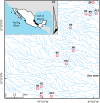The surrounding landscape influences the diversity of leaf-litter ants in riparian cloud forest remnants
- PMID: 28234948
- PMCID: PMC5325296
- DOI: 10.1371/journal.pone.0172464
The surrounding landscape influences the diversity of leaf-litter ants in riparian cloud forest remnants
Abstract
Riparian vegetation is a distinctive and ecologically important element of landscapes worldwide. However, the relative influence of the surrounding landscape on the conservation of the biodiversity of riparian remnants in human-modified tropical landscapes is poorly understood. We studied the surrounding landscape to evaluate its influence on leaf-litter-ant alpha and beta diversity in riparian remnants in the tropical montane cloud forest region of central Veracruz, Mexico. Sampling was carried out in 12 sites with riparian vegetation during both rainy (2011) and dry (2012) seasons. Ten leaf-litter samples were collected along a 100-m transect per site and processed with Berlese-Tullgren funnels and Winkler sacks. Using remotely-sensed and ground-collected data, we characterized the landscape around each site according to nine land cover types and computed metrics of landscape composition and configuration. We collected a total of 8,684 ant individuals belonging to 53 species, 22 genera, 11 tribes, and 7 subfamilies. Species richness and the diversity of Shannon and Simpson increased significantly in remnants immersed in landscapes with a high percentage of riparian land cover and a low percentage of land covers with areas reforested with Pinus, cattle pastures, and human settlements and infrastructure. The composition of ant assemblages was a function of the percentage of riparian land cover in the landscape. This study found evidence that leaf-litter ants, a highly specialized guild of arthropods, are mainly impacted by landscape composition and the configuration of the focal remnant. Maintaining or improving the surrounding landscape quality of riparian vegetation remnants can stimulate the movement of biodiversity among forest and riparian remnants and foster the provision of ecosystem services by these ecosystems. Effective outcomes may be achieved by considering scientific knowledge during the early stages of riparian policy formulation, in addition to integrating riparian management strategies with broader environmental planning instruments.
Conflict of interest statement
Figures



References
-
- Granados-Sánchez D, Hernández-García M, López-Ríos G (2006) Ecología de las zonas ribereñas. Revista Chapingo Serie ciencias forestales y del ambiente 12: 55–69.
-
- García-Martínez MÁ, Escobar-Sarria F, López-Barrera F, Castaño-Meneses G, Valenzuela-González JE (2015) Value of Riparian Vegetation Remnants for Leaf-Litter Ants (Hymenoptera: Formicidae) in a Human-Dominated Landscape in Central Veracruz, Mexico. Environmental entomology 44: 1488–1497. 10.1093/ee/nvv141 - DOI - PubMed
-
- Richardson JS, Naiman RJ, Swanson FJ, Hibbs DE (2005) Riparian commuties associated with pacific northwest headwater streams: assemblages, processes and uniqueness. Wiley Online Library.
MeSH terms
Substances
LinkOut - more resources
Full Text Sources
Other Literature Sources

